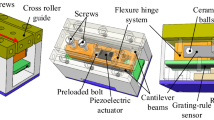Abstract
Friction behaviors of linear rolling guides (LRGs) are determined by many factors and are crucial for precision positioning. It is difficult to create an expression to describe the friction behaviors exactly and completely. A new experimental method for measuring the friction behaviors of one LRG individually was developed, and linear motor direct drive technology is utilized in the experiment setup. The position signal is acquired by a grating, and the friction of the LRG is deduced by the product of the mass of the moving part and its acceleration. In the experiment, the LRG can move with the friction only, and the friction transition from normal rolling to pre-rolling stage was detected. The asperities’ deformations were utilized to explain it. Hysteresis loops and internal loops were measured. The results indicate the non-local memory of the LRG, and the historical trajectory have an important impact on the friction behaviors of LRGs in the pre-rolling stage.








Similar content being viewed by others
References
Chen JS, Chen KC, Lai ZC et al (2003) Friction characterization and compensation of a linear-motor rolling-guide stage. Int J Mach Tool Manu 43:905–915
Al-Bender F, Symens W (2005) Characterization of frictional hysteresis in ball-bearing guideways. Wear 258:1630–1642
Urbakh M, Klafter J, Gourdon D et al (2004) The nonlinear nature of friction. Nature 430:525–528
Fukada S, Fang B, Shigeno A (2011) Experimental analysis and simulation of nonlinear microscopic behavior of ball screw mechanism for ultra-precision positioning. Precis Eng 35:650–668
Fujita T, Matsubara A, Yamazaki K (2001) Experimental characterization of disturbance force in a linear drive system with high-precision rolling guideways. Int J Mach Tool Manu 51:104–111
Kaneko S, Sato R, Tsutsumi M (2008) Mathematical model of linear motor stage with non-linear friction characteristics. J Adv Mech Des Syst 2:675–684
Fujii Y (2004) An optical method for evaluating frictional characteristics of linear bearings. Opt Laser Eng 42:493–501
Fujii Y, Maru K, Jin T et al (2010) A method for evaluating dynamical friction in linear ball bearings. Sensors 10:10069–10080
Fujii Y, Maru K (2010) Optical method for evaluating dynamic friction of a small linear ball bearing. Tribol Trans 53:169–173
Yi YS, Kim YY, Choi JS (2008) Dynamic analysis of a linear motion guide having rolling elements for precision positioning devices. J Mech Sci Technol 22:50–60
Al-Bender F, Symens W (2005) Dynamic characterization of hysteresis elements in mechanical systems. I. Theoretical analysis. Chaos 15:13105
Symens W, Al-Bender F (2005) Dynamic characterization of hysteresis elements in mechanical systems. II. Experimental validation. Chaos 15:13106
Wu JS, Chang J, Tsai G et al (2012) The effect of bending loads on the dynamic behaviors of a rolling guide. J Mech Sci Technol 26:671–680
Greenwood JA (1997) Analysis of elliptical Hertzian contacts. Tribol Int 30:235–237
Chen SL, Lin WM, Chang TH (2008) Tracking control for a synchronized dual parallel linear motor machine tool. Proc Inst Mech Eng I 222:851–862
Wang L, Tang Y (2009) Fuzzy cross-coupling control for dual linear motors based on preview feedforward Compensation. Proceedings of the 2009 IEEE international conference on mechatronics and automation. Changchun, 2138–2142
Vakis AI (2014) Asperity interaction and substrate deformation in statistical summation models of contact between rough surfaces. J Appl Mech 81:041012
Greenwood JA, Williamson JBP (1966) Contact of nominally flat surfaces. Proc R Soc Lond A 295:300–319
Al-Bender F, Lampaert V, Swevers J (2004) A novel generic model at asperity level for dry friction force dynamics. Tribol Lett 6:81–93
De Moerlooze K, Al-Bender F, VanBrussel H (2010) A generalised asperity-based friction model. Tribol Lett 40:113–130
Armstrong B, Dupont P, de Wit C (1994) A survey of models, analysis tools and compensation methods for the control of machines with friction. Automatica 30:1083–1138
Mekid S (2004) A non-linear model for pre-rolling friction force in precision positioning. Proc Inst Mech Eng J 218:305–311
Tabor D (1995) The mechanism of rolling friction. II. The elastic range. Proc R Soc Lond A 229:198–220
De Moerlooze K, Al-Bender F, VanBrussel H (2011) Modeling of the dynamic behavior of systems with rolling elements. Int J Nonlinear Mech 46:222–233
Mayergoyz ID, Bertotti G (2005) The science of hysteresis: mathematical modeling and applications, vol 1. Elsevier, Oxford
Bojana D (2012) Mechanical models of friction that exhibit hysteresis, stick-slip, and the Stribeck effect. Dissertation, The University of Michigan, 2012
Rizos DD, Fassois SD (2004) Presliding friction identification based upon the Maxwell slip model structure. Chaos 14:431–445
Acknowledgments
This work was supported by the Major State Basic Research Development Program of China (2009CB724200). The authors wish to thank Prof. Jiuhui Wu and Mr. Song Feng for their help with this work.
Author information
Authors and Affiliations
Corresponding author
About this article
Cite this article
Xi, Y., Zhou, Y., Zhang, W. et al. An experimental method for measuring friction behaviors of linear rolling guides. Chin. Sci. Bull. 59, 3912–3918 (2014). https://doi.org/10.1007/s11434-014-0503-3
Received:
Accepted:
Published:
Issue Date:
DOI: https://doi.org/10.1007/s11434-014-0503-3




